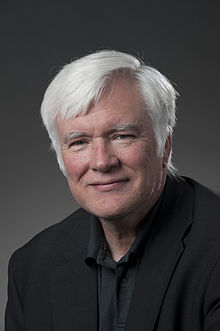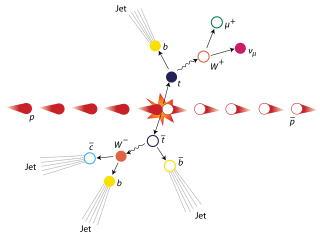Christopher T. Hill | |
|---|---|
 | |
| Born | June 19, 1951 |
| Nationality | American |
| Alma mater | Massachusetts Institute of Technology (BS, MS) California Institute of Technology (PhD) |
| Known for | Infrared fixed point of the top quark; Topcolor; Top quark condensate; Dimensional deconstruction; Chiral symmetry breaking in Heavy-Light Mesons; Theory of UHE Cosmic Rays; Soft Nambu-Goldstone Boson model of Dark Matter. |
| Scientific career | |
| Institutions | Fermilab |
| Thesis | Higgs scalars and the nonleptonic weak interactions (1977) |
| Doctoral advisor | Murray Gell-Mann |
Christopher T. Hill (born June 19, 1951) is an American theoretical physicist at the Fermi National Accelerator Laboratory who did undergraduate work in physics at M.I.T. (B.S., M.S., 1972), and graduate work at Caltech (Ph.D., 1977, Murray Gell-Mann [1] ). Hill's Ph.D. thesis, "Higgs Scalars and the Nonleptonic Weak Interactions" (1977) contains one of the first detailed discussions of the two-Higgs-doublet model and its impact upon weak interactions. [2] His work mainly focuses on new physics that can be probed in laboratory experiments or cosmology.
Contents
Hill is an originator, with William A. Bardeen and Manfred Lindner, of the idea that the Higgs boson is composed of top and anti-top quarks. This emerges from the concept of the top quark infrared fixed point, [3] with which Hill predicted (1981) that the top quark would be very heavy, contrary to most popular ideas at the time. The fixed point prediction lies within 20% of the observed top quark mass (1995). This implies that the top quarks may be strongly coupled at very short distances and could form a composite Higgs boson, which led to top quark condensates, [4] topcolor, [5] [6] and dimensional deconstruction, a renormalizable lattice description of extra dimensions of space. [7] The original minimal top condensation model predicted the Higgs boson mass to be about twice the observed value of 125 GeV, but extensions of the theory achieve concordance with both the Higgs boson and top quark masses. Several new heavy Higgs bosons, such as a b-quark scalar bound state, may be accessible to the LHC. [8] [9] [10]
Hill coauthored (with Elizabeth H. Simmons) a comprehensive review of strong dynamical theories and electroweak symmetry breaking that has shaped many of the experimental searches for new physics at the Tevatron and LHC. [11]
Heavy-light mesons contain a heavy quark and a light anti-quark, and provide a window on the chiral symmetry dynamics of a single light quark. Hill and Bardeen showed that the (spin)parity ground states are split from the parity partners by a universal mass gap of about due to the light quark chiral symmetry breaking. [12] This correctly predicted an abnormally long-lived resonance, the (and the now confirmed ), ten years before its discovery, and numerous decay modes which have been confirmed by experiment. [13] Similar phenomena should be seen in the mesons and (heavy-heavy-strange baryons).
Hill is a contributor to the theory of topological interactions and, with collaborators, was first to obtain the full Wess-Zumino-Witten term for the standard model which describes the physics of the chiral anomaly in Lagrangians, including pseudoscalars, spin-1 vector mesons, and the and . The WZW term requires a non-trivial counter-term to map the "consistent" anomaly into the "covariant" anomaly, as dictated by the conserved currents of the standard model. With the full WZW-term, new anomalous interactions were revealed such as the vertex. This leads to where is a heavy nucleus, and may contribute to excess photons seen in low energy neutrino experiments. [14] The result reproduces B+L violation by the anomaly in the standard model, and predicts numerous other anomalous processes. Hill has given a derivation of the coefficients of consistent and covariant chiral anomalies (even D), and Chern-Simons terms (odd D), without resorting to fermion loops, from the Dirac monopole construction and its generalization ("Dirac Branes") to higher dimensions. [15]
Hill is an originator of cosmological models of dark energy and dark matter based upon ultra-low mass pseudo-Nambu-Goldstone bosons associated with symmetries of neutrino masses. He proposed that the cosmological constant is connected to the neutrino mass, as [16] [17] and developed modern theories of the origin of ultra-high-energy nucleons and neutrinos from grand unification relics. [18] [19] [20] [21] He has shown that a cosmic axion field will induce an effective oscillating electric dipole moment for any magnet. [22] [23]
In an unpublished talk at the Vancouver Workshop on Quantum Cosmology (May, 1990), Hill discussed possible roles for Nambu-Goldstone bosons in cosmology and suggested that a pseudo-Nambu-Goldstone boson might provide a "natural inflaton," the particle responsible for cosmic inflation. He noted that this required a spontaneously broken global symmetry, such as U(1), near the Planck scale, and explicit symmetry breaking near the Grand Unification Scale. The idea seemed ad hoc, however subsequent work on Weyl invariant theories offered a better rationale for a natural inflation scenario connected to Planck scale physics. Hill collaborated with Graham Ross and Pedro G. Ferreira and focused on spontaneously broken scale symmetry (or Weyl symmetry), where the scale of gravity (Planck mass) and the inflationary phase of the ultra-early universe are generated together as part of a unified phenomenon dubbed "inertial symmetry breaking." The Weyl symmetry breaking occurs because the Noether current is the derivative of a scalar operator, called the "kernal." During a period of pre-Planckian expansion any conserved current must red-shift to zero, hence the kernal approaches a constant value which determines the Planck mass and the Einstein-Hilbert action of General Relativity is emergent. The theory is in good agreement with cosmological observation. [24] [25] [26]
Hill has returned to the issue of composite scalars in relativistic field theory, developing a novel analytic approach to bound states of chiral fermions by generalizing the Nambu--Jona-Lasinio model to non-pointlike interactions. [27] [28] He feels the most important challenge to the CERN LHC program is to determine if the Brout-Englert-Higgs boson is a pointlike fundamental particle or a composite bound state near the TeV energy scale. The former case may evidence some yet-to-be developed version of Supersymmetry; the latter case would imply new dynamics.


















